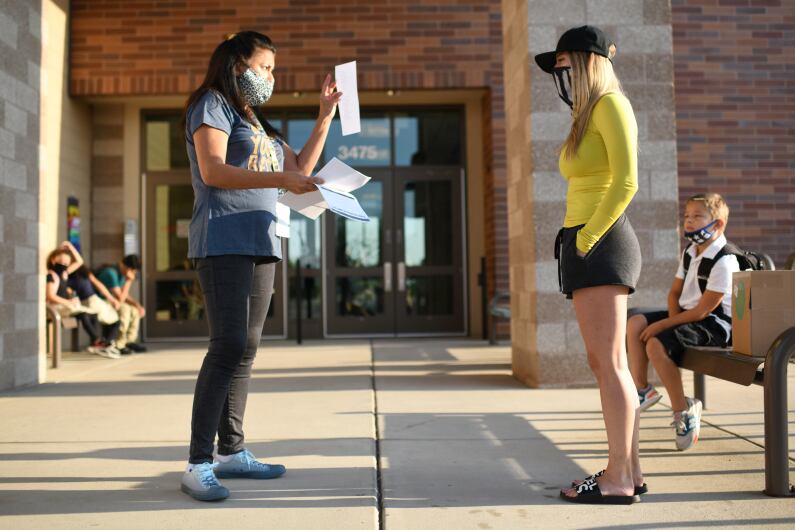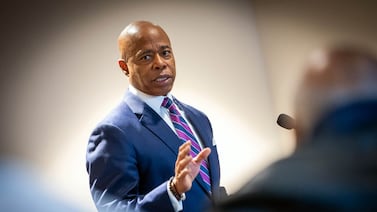Update: Since this article was published, Colorado changed its quarantine guidelines, and the state convened a task force to work on getting kids back in school. Staffing shortages and disruption remain a problem school districts will have to address if or when children return to the classroom.
Superintendent Scott Siegfried can look at his meticulous charts and see a day in early November where his suburban Denver district “broke.” On the graph, it’s marked “operationally impossible to continue in-person.”
Dozens of new COVID cases among students and staff were being reported every day, each one triggering quarantine requirements that sent dozens more people home for 14 days. In the first weeks of November, the 53,000-student Cherry Creek district sent out more than 100 letters notifying the community of positive COVID cases in schools and associated quarantines.
“We had so many positive cases coming into schools that we were running schools without principals, without office managers, without entire groups of teachers,” he said. And without substitutes, there was no one to fill those gaps. “You can’t keep up.”
State quarantine rules have been the price students, parents, and teachers paid to hold school in person. Now, as a growing number of school districts move to fully remote learning, many superintendents are pointing to widespread quarantines and associated staffing shortages as key factors. Some district leaders are calling for public health officials to give them more flexibility about who to send home when students or staff members test positive.
There is no consensus on whether the current rules should change, especially as hospitals around the state feel the strain of a COVID surge, and data that would inform a change is in short supply. District leaders are under immense pressure from parents and advocates who want more in-person learning, on the one hand, and teachers and their unions who worry that safety will be compromised, on the other.
‘Nothing smooth about quarantine’
Since Colorado students returned to classrooms in August, thousands of teachers and tens of thousands of students have had to abruptly enter quarantine after learning they had been exposed to COVID. Thousands more have had to learn from home due to “operational closures” when so many adults were out that it was not possible to run the school safely.
Even earlier in the year, when most districts were holding classes in person, managing quarantines was a challenging job. Many school districts had to do the bulk of their own contact tracing and communications because public health agencies didn’t have the resources. Some teachers worried these efforts weren’t thorough enough to keep everyone safe. People who tested positive sometimes found themselves the target of resentment for exposing others and sending them home.
Students and teachers had to rapidly switch from in-person to online instruction and back again. Everyone lived with uncertainty about daily changes.
“There is nothing smooth about quarantine,” said Sydney Slifka, a Jeffco elementary teacher who has had to quarantine twice due to exposure from the high school volleyball team she coaches. As a remote teacher, students were constantly coming in and out of her online classes due to quarantine. “It is abrupt, unplanned, and extremely disruptive to the flow of curriculum and instruction for students.”
“My students and I had just gotten used to in-person routines and had just started making progress,” said Denver second-grade teacher Lindsay Knickerbocker, who was back in school for 10 days before getting an exposure notification. “Many kids seemed defeated coming back to class online the next day. I felt defeated as well.”
Many teachers describe quarantine as stressful and wondered how well people who potentially had been exposed were being tracked. In particular, educators who work across classrooms and cohorts — art, music, and drama teachers, school psychologists, behavior specialists, special education providers — worry that they’re more exposed and at risk of exposing others.
“My admin doesn’t know where I am at any given moment because I might get called in to deal with something,” said Devani Lemmon, who helps resolve student conflicts at Bear Creek High School in the Jefferson County district. “Now I’m counting on teachers who are dealing with all this other stuff to tell me if I was in the room with a sick kid.”
Each call about a positive case has provoked a feeling of, “Oh no, here we go again,” said Westminster Superintendent Pam Swanson. “We all have that dread.”
Westminster’s first positive cases and quarantines came the same week buildings opened in August. At least one outbreak traced back to students socializing outside of school. Next spring, the district will ask students who play sports to switch to remote learning during their season so cases on athletic teams don’t also take down academic classes.
A big job with not enough people to do it
Each positive case requires a school district to convene a team to figure out where the person was in the previous 48 hours, whether they rode the bus and where they ate lunch, whether they participated in any sports or received special services.
Cherry Creek’s team includes four people, said Siegfried, the superintendent, down from 15 to 20 in the beginning.
Many public health departments — including Tri-County Public Health, which supports more than a dozen school districts, and Jefferson County Public Health — have teams to assist school nurses but not enough staff to follow up on every case associated with a school. Instead, they advise school districts on how to do contact tracing, an additional task for school nurses, building principals, and others.
Lori McCarty, health services coordinator for the Greeley-Evans district, said school nurses have gotten little outside help.
Over the summer, Gov. Jared Polis promised rapid response teams would respond to school-based outbreaks. But when McCarty asked if one of these teams could help her district with tracking a growing number of COVID caes, she was told there was no one available.
“There aren’t enough bodies anywhere to do this work,” she said.
A Polis spokesman said that the rapid response team assisted with 20 school-based outbreaks but are not currently helping on any.
The sheer size of the task has meant that sometimes people slip through the cracks.
“Sometimes you find out the kid rode the bus 12 days into the quarantine,” McCarty said. “It’s kind of late to quarantine at that point, but you can track those kids, at least.”
When the Greeley-Evans district moved to remote learning in mid-November, the district had 160 confirmed cases among students and staff, one confirmed outbreak, numerous suspected outbreaks, and more than 3,000 people in quarantine.
Evolving rules
Colorado’s case and outbreak guidance for schools, which runs 22 pages, initially required anyone to stay home for 14 days if they were in a class, on a sports team, or in an after-school program with a person who tested positive or had COVID-like symptoms and a known exposure.
In school districts that don’t maintain careful cohorts — particularly at the middle and high school level where students change classes more frequently and have more exposure — a single case could send hundreds of students home.
State officials made a significant change in early October to allow schools in counties with lower levels of transmission to take a more targeted approach. If they maintained detailed seating charts and made sure students stayed in those seats, only close contacts — people who were within 6 feet of the COVID-positive person for more than 15 minutes — would have to quarantine.
The number of people sent home dropped. As recently as a month ago, many Colorado superintendents said the quarantine system was working.
“We’ve actually got a good system down,” Siegfried said in late October, when in-person learning still seemed feasible. “We understand the health guidance and health metrics, and we’re able to do the right thing, not go too far and not do too little.”
Polis also praised the quarantine rules for limiting transmission in Colorado schools.
“Outbreaks have been contained early,” he said at an October press conference.
In the middle of an experiment
The dramatic rise in COVID cases over the last month meant many school districts lost the ability to do targeted quarantines. State rules require districts in communities at higher levels of restrictions to quarantine entire classrooms or cohorts. While Colorado school districts are allowed to offer in-person learning even under the tightest restrictions, school leaders say the staffing shortages and disruption make it impossible to keep school buildings open.
“The disruptions are getting to the place where it is impacting our ability to deliver a quality education,” said Jeffco school board President Sue Harmon at a recent meeting.
Some of them want the state to change its rules again to keep more flexibility. Parents who want kids to stay in school through the pandemic are also pushing for modified quarantine rules.
“Schools are going to have to figure out how to keep operating regardless of what is going on in the community,” said Cindy Myers, a nurse and Denver parent who is part of a coalition calling for a return to school.
It’s an idea that alarms many teachers, who already question whether current rules are adequate.
“Any changes to the guidance should be based on science and not driven by other reasons,” said Amie Baca-Oehlert, president of the Colorado Education Association, the state’s largest teachers union. “We believe low spread in schools is because they are strictly implementing the guidance.”
What the science says about how much quarantine is enough is still evolving. While children are at lower risk of serious illness from COVID, they can get sick and can infect others, said Elizabeth Carlton, an associate professor at the Colorado School of Public Health at Anschutz and an environmental epidemiologist who runs the state’s COVID modeling team. Quarantine is part of a multilayered approach to stop transmission in schools, she said.
“Quarantine is really frustrating for people who are put in it, and one of the struggles is to get buy-in, but it can be a really powerful tool for shutting down transmission,” Carlton said.
School quarantine practices around the country range from keeping anyone exposed out of school for a full two-week quarantine to telling people to wear a mask and monitor for symptoms while continuing to go to school, said David Rubin, a professor of pediatrics and director of PolicyLab at the Children’s Hospital of Philadelphia. Schools are so critical to children’s well-being that Rubin supports more limited quarantines when community rates are low or moderate, but the rate of COVID in Colorado raises questions about whether it’s safe to be in schools.
Colorado public health officials have said they are not looking at any changes to the rules, and some local public health officials said they don’t believe a more targeted approach is appropriate when community spread is so high.
“It leaves school communities vulnerable to increased COVID-19 transmission when there is a large prevalence of disease in the community,” Melanie Rogers, a nurse epidemiologist with Jefferson County Public Health, in an email. “When the prevalence decreases, then that opens up additional infection control options.”
Little data has been collected that would help answer the question of which quarantine policies strike the best balance.
“We’re in the middle of this natural experiment,” Rubin said. “We need that data desperately.”
Testing the limits
Colorado doesn’t collect information on individual cases in schools, how many people have had to quarantine, and how many of them or their household members later test positive.
Siegfried has been collecting data from Cherry Creek and 34 other school districts, asking them every week how many students and staff were in quarantine after being exposed and how many of those people later tested positive. Out of 29,160 students who had to quarantine, 142 — 0.5% — later tested positive. Out of 5,196 staff members, 118 — or 2.3% — tested positive.
To Siegfried, this is evidence that schools are not major drivers of transmission, especially for children. There is a limitation, though: Not everyone in the groups was tested.
The information Siegfried collected also shows the impact of rising cases in the community: More people are getting exposed at school and entering quarantine, and the percentage of those people who test positive is inching up, from just 0.6% in the second week of October to 1.3% — 91 new cases — in the second week of November.
In another sign that transmission may be increasing in schools, the number of confirmed outbreaks reported by the state doubled in the second week of November to 189. Outbreaks occur when two or more people in a cohort — or a larger number of people across a school — who are not part of the same household test positive in a two-week period.
Not all district leaders want to see the quarantine rules change. Siegfried notes he still had the ability to do targeted quarantines when he made the call to move to remote learning. Theresa Myers, a spokeswoman for the Greeley-Evans district, said it was the sheer number of cases the district had to respond to, as well as high rates in the community, that drove the decision to move to remote learning after 13 weeks in person.
On the ground, in the classroom
Teachers have struggled to cope with quarantines. Among more than four dozen who responded to a Chalkbeat survey, even those who found the experience stressful often praised their administrators’ handling of difficult situations and said they were able to make smooth transitions to remote learning.
But others described chaotic notification and contact tracing procedures that left them worried about how well students and people who work in schools are protected. Teachers in multiple districts described students who were supposed to be home on quarantine showing up to school anyway. In some cases, they made it into their first class before anyone noticed.
Quarantine makes teaching difficult. One counselor told Chalkbeat she had to cancel multiple appointments because she had nowhere private to talk to students while at home with her own children.
One Jeffco teacher said she felt like parents were angry at her for contracting COVID, even though she took numerous precautions in her personal and professional life.
Sara Price, a teacher at Animas High School in Durango, was in the grocery store when she got a text. A student in her 12th grade humanities class had tested positive for COVID-19, and she would need to quarantine for the next two weeks.
Price thinks her school administration did everything right, from a quick notification process to setting up drive-through testing for students, but that didn’t make it easy.
She couldn’t see her adult daughter, who has an autoimmune disease. She couldn’t see her mom. She couldn’t go hiking with friends. She couldn’t run out to the store to get ingredients to bake a pie.
When she did leave the house, she wore a mask even if she was going to be outside, something that made her stand out in her southwest Colorado community. And of course she wondered if she had caught COVID at school.
“I had intense fear, and I didn’t have as many ways to get support,” Price said.
Price, who ultimately stayed well, kept teaching online through quarantine. She found herself making daily phone calls to students having a hard time learning at home.
“In those two weeks, those kids who struggle the most did fall off the cliff,” she said. “I don’t think most students are developmentally prepared to self-motivate at home.”
Most disheartening, though, was the news that a group of students had attended a Halloween party the Saturday they were released from quarantine.
“I don’t think I can teeter-totter between quarantines for the next four months,” she said.








